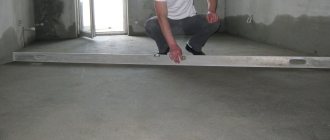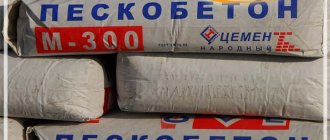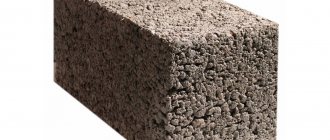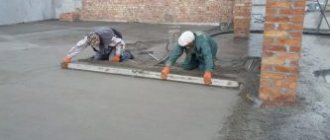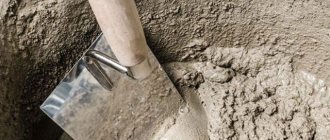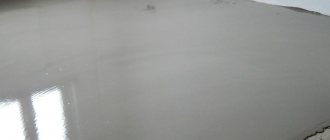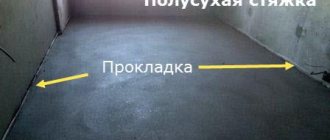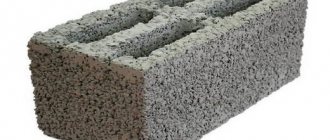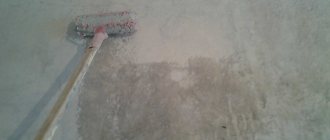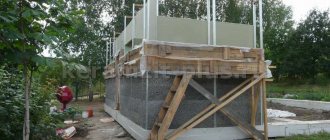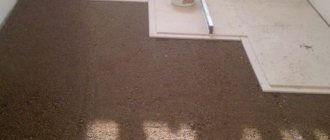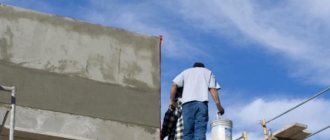In recent years, quite often, many builders began to use expanded clay when constructing dry floor screeds. This material has excellent thermal insulation properties with its light weight and easy installation method.
To calculate the consumption of expanded clay for floor screed per 1 m2, it is not necessary to use a calculator. Since there are special online programs with which this can be done simply and easily.
When to choose expanded clay
The range of heat-insulating materials on the modern market is so large that it can be difficult to settle on just one. However, it is worth learning the full range of properties of this unique material in order to understand that there is no better option than to insulate the floor with expanded clay.
A list of properties that make this simple material a leader among its competitors:
- Low thermal conductivity - the porous material contains air bubbles, which provide high-quality thermal insulation. A 10 cm layer of expanded clay exceeds the thermal conductivity parameters of a similar wooden surface by 3 times, and brickwork by 10 times.
- Sound insulation is a property that is in demand in apartments of multi-storey buildings; the expanded clay floor will serve as a reliable barrier to the penetration of noise from neighbors below, while simultaneously preventing the spread of sounds in the opposite direction.
- The strength of the material allows it to be used in the bottom layer of the floor pie without additional supporting structures (expanded clay is available in different grades of strength from 250 to 600).
- Resistance to rot and fungi, mold (unlike wood-based materials) increases the service life of the floor and its durability.
- Chemical inertness - expanded clay is a natural material, does not release any substances into the environment, and is also resistant to chemicals.
- Heat resistance - quality is important in terms of fire safety.
- Frost resistance - expanded clay does not lose its properties at extremely low temperatures.
- Light weight - allows you to insulate the floor with expanded clay under a screed in houses where a large load on the floors is undesirable (read: “Insulating the floor under a screed - practical tips”).
- The granular fraction of the material makes it easy to work with - one person who does not have construction skills can handle the backfill.
- Low cost is an additional bonus for a material that has a range of excellent qualities.
The only disadvantage of expanded clay is its ability to retain moisture for a long time. This drawback can be easily mitigated by following the technology of installing a floor with expanded clay and carefully gluing the waterproofing layer.
Expanded clay in bags: features and positive qualities of the material
Expanded clay has long been used in various areas of production due to a number of its positive qualities. This is a lightweight, natural and environmentally friendly material that is made from clay. It is practical to use and provides a high degree of noise insulation and heat conservation in rooms. The thermal conductivity coefficient of the material is quite low - 0.1-0.18 W/m K.
The advantages of expanded clay include its high thermal insulation properties, as well as resistance to fungi and mold.
Additional advantages of expanded clay are its relative moisture resistance, frost and fire resistance, as well as biostability. Fungus does not form in it and rodents do not breed. Correctly selected proportions, quantities and adherence to laying technology guarantee the reliability of the expanded clay screed and its long service life.
In large quantities, expanded clay is used as drainage on roads, to create sidewalks and embankments in the garden. It's quite easy to work with. However, before you buy expanded clay in bags or in bulk, you need to correctly calculate the required amount of material.
Expanded clay granules have different shapes. They are obtained from special types of clay, characterized by a high degree of swelling at high temperatures. Thanks to these qualities, pores appear, which provide the thermal insulation properties of the material.
Packaged expanded clay in bags is a higher quality and purified material
Expanded clay is produced in bulk and in bags in three types. Sand has granules up to 5 mm in diameter. Gravel has a more rounded shape, and the grain size reaches 20 mm. Crushed stone is a more angular material, its fraction is 20-40 mm.
Expanded clay density and material grade
Expanded clay is lightweight, and the density of the material determines its quality and area of use. It is this value that affects its quantity per cubic meter and, consequently, the weight of the expanded clay bag. This indicator depends on the fraction: the larger the granules, the lower the density of the material.
Helpful advice! When purchasing expanded clay, you must take into account the bulk density, which indicates the grade of the material.
The quality of expanded clay is determined by its bulk density index and manufacturing method
Production technology affects the density of the material. There are four ways to obtain this material:
- Dry. The simplest technology applied to homogeneous types of clay without impurities. Humidity does not exceed 9%.
- Wet.
- Plastic. The most common method. Granules are formed from wet clay and sent to the oven. The humidity of the raw materials reaches 30%.
- Powder-plastic. It is similar to the previous method, but the basis is dry clay, which is crushed, and then moistened and subjected to temperature influences.
It is the bulk density that is the brand of expanded clay. It is designated by the letter M with the corresponding number. For example, M300 means that 1 cube of expanded clay weighs from 251 to 300 kg. The lower the grade, the higher the thermal insulation properties. This material is best suited for insulating ceilings and floors.
In construction, expanded clay is most often used to insulate floors, walls and ceilings.
Expanded clay of a lower grade (fractions 20-40) is used as a heat insulator in foundations and basements. It is widely used for landscape design. Material with a minimum density is used to insulate walls, communications and facades. The finest expanded clay (with a fraction of up to 10 mm) is used in the preparation of expanded clay concrete for pouring floors.
Specific density and specific gravity of expanded clay
The density of expanded clay is measured using the bulk method, as well as by calculating its volumetric weight. This characteristic indicates the true weight of sand, crushed stone or gravel - without taking into account the space in the middle of the expanded clay granules. This feature underlies the difference between bulk and true density, which almost always differ from each other. True density is a constant indicator; it can only be measured in special laboratories. The specific gravity varies depending on the grain fraction.
The table clearly shows how much a cube of expanded clay weighs:
| Type of expanded clay | Granule fraction, mm | Specific gravity of the material, g/cm3 |
| Sand | 0,1-5 | 0,55-0,6 |
| fine gravel | 6-10 | 0,4-0,55 |
| Coarse gravel | 10-20 | 0,35-0,4 |
| Crushed stone | 20-40 | 0,2-0,35 |
The weight of sand can reach 600 kg per cubic meter, fine gravel - 450 kg, coarse gravel - 400 kg. A cube of crushed stone will weigh at least 350 kg. The higher the density of expanded clay, the greater the weight of the material. These indicators are regulated by the existing GOST.
The exact specific gravity of expanded clay is difficult to determine; you can only establish the average value, which is 400 kg/m³ (0.4 g/cm³). This indicator is influenced primarily by the size of the fraction. For example, a bag of expanded clay with a volume of one cube and a fraction of 10-20 weighs approximately 16.7 kg.
Preparation is an important step
Preparing the base for filling with expanded clay begins with cleaning the surface. A clean base is assessed for curvature and differences in plane. This is done in order to see what layer of expanded clay is needed to insulate the floor, level the surface and calculate the required amount of material.
The optimal layer thickness is 80 - 100 mm; to determine the required number of granules, make a mark on the wall to a height of 8 cm at the highest point of the room, from which then, using a level, mark a horizontal line around the perimeter of the room.
The average backfill height is obtained by measuring the distance to the horizontal line in several places, which is then divided by the number of measurements. So, if three measurements are made with values of 10, 15, 8 cm, then the average height of the backfill will be (10 + 15 + 8): 3 = 11 cm. Then the area of the room (width x length) is multiplied by the height (average value) obtained the number indicates how much expanded clay is needed to insulate the floor of this room.
Attention: practitioners recommend purchasing material 10% more than the calculated figure in order to protect yourself from the need to interrupt work due to errors in calculations and the lack of a handful of insulation.
Preparation itself comes down to the following steps:
- Sealing cracks and potholes with mortar (for concrete floors).
- Waterproofing the base. To do this, use any available technologies and materials: special mastic, preparation of a waterproofing solution from polymer dry mixtures. If the floor is insulated with expanded clay on the ground, then the optimal solution would be polyethylene film (not thinner than 100 microns) or rolled material (roofing material).
Dry and method
In many cases, floor screed using expanded clay is performed using a dry method.
And this is not surprising, because this method takes less time and effort from workers, in contrast to the classic options using concrete. Such a floor is installed according to the principle of laying a waterproofing and leveling layer from gypsum fiber sheets specially designed for this work. At the initial stages, you will need plastic film. It is laid on the base if it is concrete. In the case of a wooden floor, use paper impregnated with bitumen or roofing felt. Expanded clay is used here as a dry backfill on previously laid polyethylene. GVL sheets, chipboard or asbestos-cement boards are attached to it on top. If we talk about the advantages of this method of floor leveling, then they can safely include:
- ease of installation;
- absence of dust and other debris;
- good sound and thermal insulation;
- decorative coating (tiles, laminate or linoleum) can be laid immediately after installation is completed.
Like any other type of construction work, dry screed has its disadvantages. But there are not many of them. The main disadvantage is considered to be the high cost of materials for installation. But at the same time, the high costs of materials are compensated by the minimal cost of work on its installation. Another minor drawback is the large thickness. It would be unwise to install it in rooms with low ceilings.
Consumption of materials
Before you begin leveling the floor using the dry method, you need to correctly calculate the proportions of all components and their consumption. It is important to know how much expanded clay is needed for dry backfilling. In addition to this material, you will also need to calculate the quantity of other components. For example, how much polyethylene film, screws and bolts, edge tape, gypsum fiber sheets, PVA glue, as well as profiles that are needed when installing beacons are needed. The material is calculated using several standard indicators. These include:
- thickness of the screed (backfill);
- quadrature of the room where the floor is installed;
- options for placement and size of materials.
The consumption of a material such as expanded clay must be determined based on the thickness of the planned floor screed. Where the average value is usually taken as a basis. This is especially important when the original foundation has large variations. You need to determine the approximate average thickness of the backfill based on the smallest and largest measurements of its height. Using a building level, you must first draw the upper horizon for the layer on the walls.
To calculate expanded clay for dry leveling the floor, you need to multiply the area of the room by the thickness of the backfill. It is worth noting that it will be quite difficult to make an accurate calculation, so it is better to buy it with a small reserve.
Methods for insulating floors with expanded clay
There are several ways to insulate and level a floor with expanded clay. The choice is made based on the features:
- Surfaces;
- Permissible load on the base;
- Room assignments.
Thus, a dry expanded clay cushion is lighter than an expanded clay screed of the same thickness. The thermal insulation properties of dry expanded clay are also higher, but the surface strength and ability to withstand loads are better for expanded clay concrete floors constructed using the “wet” method of preparing the solution.
Dry backfill for wooden floors
Wooden floors are laid on logs - horizontally located bars. If, during the process of dismantling the old wooden floor, it turns out that the joists are well preserved and do not require replacement, then you should not remove them, adding more work to yourself. In this case, it is easier to insulate the floor with expanded clay along the joists.
To do this, waterproofing is laid in the spaces between the joists. Then a layer of expanded clay is poured, on which a foil vapor barrier is laid. For additional warmth, you can put another layer of other insulation on top (foam plastic, expanded polystyrene) flush with the top edge of the log. Then a wooden floor is laid, the slats of which are nailed to the joists.
Thickness of expanded clay in screed
To find out exactly how much expanded clay is required for a screed, you need to determine how thick the thermal insulation layer is required. In rooms on the ground floor or above an unheated room, to ensure sufficient thermal insulation, the thickness of the expanded clay layer in the screed must be at least 10 cm. In residential premises, for sufficient thermal insulation, the thickness of expanded clay is usually made at least 3-4 cm.
Thus, the consumption of expanded clay for screeding in a standard apartment will be at least (0.03-0.04 m 3) or 30-40 liters per m 2.
Next, we need the total area of the room where we make the screed, multiply by the consumption per m 2, we get the total amount of expanded clay required.
Expanded clay consumption per 1m2 of floor screed
A necessary condition is high ceilings. If the house has low ceilings, then a layer of expanded clay with a screed will make them even lower, which will affect the comfort of living.
In this case, it is better to consider options with other materials, which will most likely cost more, but will not steal space.
Dry and fast method - clean job
The ease of laying such a floor allows you to do it yourself and quickly. Ideal for an apartment in a multi-storey building, since the weight of the structure is light and no mixing of screed mortar is required.
Operating procedure:
- Free the floor from debris and dust.
- Lay a waterproofing layer. If the waterproofing is of a liquid, flowing consistency (mastic, cement-polymer mortar), then cracks and crevices are first covered to prevent liquid from flowing into the floors.
- Beacons are installed.
- Expanded clay is poured in, and it is carefully compacted along the way.
- Lay sheets of plywood (chipboard, OSB) in two layers. The first layer is fastened together with glue, the second is screwed to the lower panels with self-tapping screws.
The dry base of such a floor is suitable for finishing with any decorative coatings: from linoleum to laminate.
Expanded clay is available in several strength classes and 4 types of granule sizes, so inexperienced home craftsmen often ask: “which expanded clay is best for floor insulation?” in order to provide the floor with the best protection from the cold.
You should know that despite the fact that the heat-saving qualities of expanded clay of a large fraction are higher, a dry screed must be installed from a mixture of materials with different sizes. This will allow you to get a solid base in which small granules will fill the space between large ones and provide a dense and durable coating. For apartments, medium (1 - 2 cm) and fine gravel (0.5 - 1 cm) are usually used.
Floor installation with expanded clay concrete screed
Expanded clay as a floor insulation material in a wooden house has no competitors due to its versatility. It can be used as an additive to cement-sand screed for constructing a concrete floor in outbuildings: garage, bathhouse. Unlike a dry base, expanded clay concrete screed has increased strength, wear resistance while maintaining good thermal insulation qualities.
The construction of the floor using the “wet method” consists of laying an aqueous solution made from sand, cement, expanded clay (ratio 2:1:3) onto a surface prepared in the usual way. As the screed is laid out, it is “slammed down” with a heavy floor polisher or a special tamper. This will allow you to get a smooth surface without roughness formed by protruding expanded clay granules.
Expanded clay calculations for screed
To calculate the screed using expanded clay and the consumption of building materials, many specialists use special programs - calculators, which can work both online and be installed on various devices (computers, tablets, smartphones). For more information about expanded clay screed, watch this video:
To carry out the calculation, we will need to decide on the initial values, which will be:
- The area of the room in which the “dry” or “wet” screed will be laid.
- Occupied height above the level of the rough floor. It is worth paying attention, since this parameter is not considered the height of the screed, but is the thickness of the “pie” being laid, which includes: waterproofing, the screed itself, rough flooring and finishing coating.
- The thickness of the screed itself (“wet” or “dry”);
- The weight of 1 bag of expanded clay and the weight of m3 of this material;
- A supply of expanded clay for raising the screed to one level.
Related article: Beautiful wet wallpaper for walls: photos and 8 advantages
Special programs will help you calculate the amount of materials
All the given parameters are driven into programs that have different appearances, but the same principle of operation.
Based on the above data, fairly reliable calculations are made, on the basis of which you can begin purchasing raw materials for the work and safely install the screed.
The table can serve as an example of the ratio of materials for organizing a screed using expanded clay. For more details on calculations, watch this video:
You should know that no matter how thoroughly the calculations are carried out, you always need to make a supply of material in a 10% ratio so that there is no shortage of it during installation.
Usually, screeds 10 cm thick are arranged (taking into account the height of the ceilings). If the work is carried out in a wooden or frame private house, then it is enough to lay expanded clay flooring 3-4 cm thick on the floors of the 2nd and 3rd floors.
Recommendations for using expanded clay
Nuances you need to know when insulating a floor with expanded clay with your own hands:
- If the heat-saving effect is a priority, then dry expanded clay is used. A dry pillow retains heat better.
- The technology of the dry method depends on which layer of expanded clay for floor insulation is sufficient in specific conditions. If the thickness of the pillow is large (more than 10 cm), then it is worth pouring two layers, separating them with gypsum board sheets. plywood, etc. This design will ensure the stability of the coating.
- To secure the beacons, you can add gypsum or alabaster to the solution - this will speed up the setting and allow you to begin filling the expanded clay immediately after setting the guides.
- The use of granules of different sizes provides better adhesion and, accordingly, greater strength.
- Reinforcing the expanded clay layer with a metal mesh increases the reliability and strength of the structure.
- The expanded clay-concrete screed reaches its final strength after 4 weeks, so you should not subject it to excessive loads right away, despite the fact that it hardens literally on the second day.
Insulating a wooden floor with expanded clay or leveling the concrete base in an apartment with your own hands will save money. They can be used on an expensive decorative coating, which will become an interior decoration and a magnificent background for home photos and videos.
